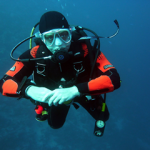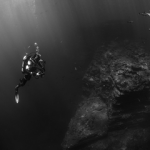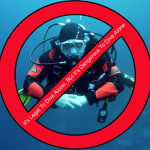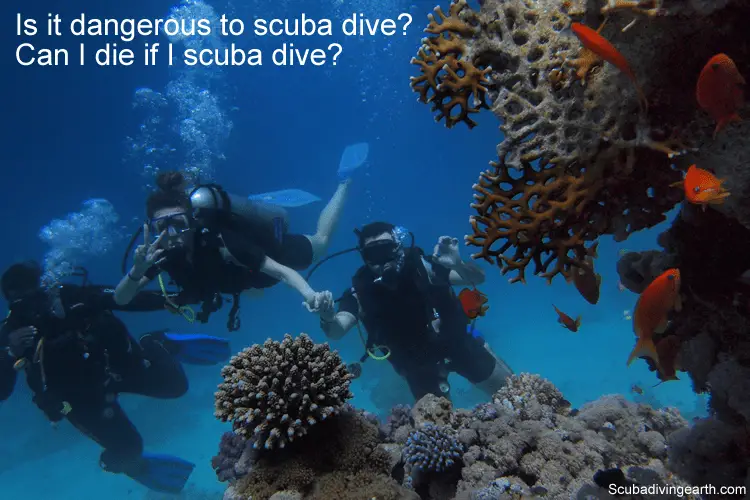
Is scuba diving dangerous?
Scuba diving is classed as a dangerous sport, but is it dangerous to scuba dive? The dangers associated with scuba diving can be minimised with the correct training and if you follow safe diving practices.
Not wishing to scare you, but scuba diving does involve an element of risk. These risks include decompression sickness (DCS, the “bends”), arterial air embolism, drowning and dangerous sea creatures. You also need to consider any contributing factors from the effects of nitrogen narcosis.
The best way to do more diving is to book yourself on a scuba diving liveaboard. You can check the latest and best deals on liveaboards using the following window:
As an aside, in this article about where to find great white sharks, you may be as surprised as I was to discover some of the places where you find great white sharks! Place number 6 is the one that surprised me the most, but if you live in the States, you may be more surprised at places two, three and four.
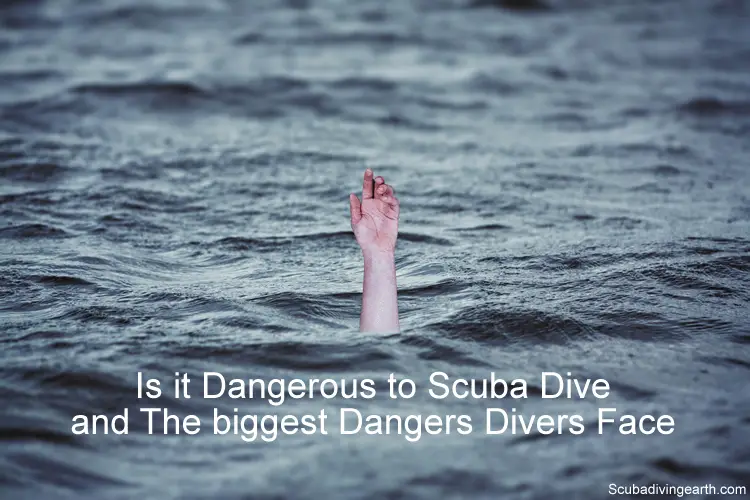
Is it dangerous to scuba dive and what are the chances of dying while scuba diving?
Scuba diving does carry risk and it is classed as a dangerous sport. But the risks can be mitigated by diving using safe diving practices.
The biggest dangers divers face is themselves. If you are careful and practice ‘safe diving‘ you will minimise most, if not all scuba diving problems or dangers.
What are the chances of dying while scuba diving?
The chances of dying whilst scuba diving are very low. Plus quite avoidable.
Life is one big series of risks. And some risks are worth the taking to enjoy life.
For example, one study shows people have a 1 in 100,000 chance of dying while attending a dance party. I’m not quite sure what they die from at these parties, but perhaps they are at wild parties?

Another study shows the odds of dying while skydiving in the United States is 1 in 101,083 jumps. When I researched whether scuba diving is more dangerous than skydiving, it turns out that it is.
For scuba diving 1 in 34,400 die each year, which is roughly three times more dangerous than skydiving. It’s almost three times more risky than going to parties too. But as already mentioned, the risks associated with scuba can be mostly avoided.
Please see below for more details of how to minimise the various risks associated with scuba diving.
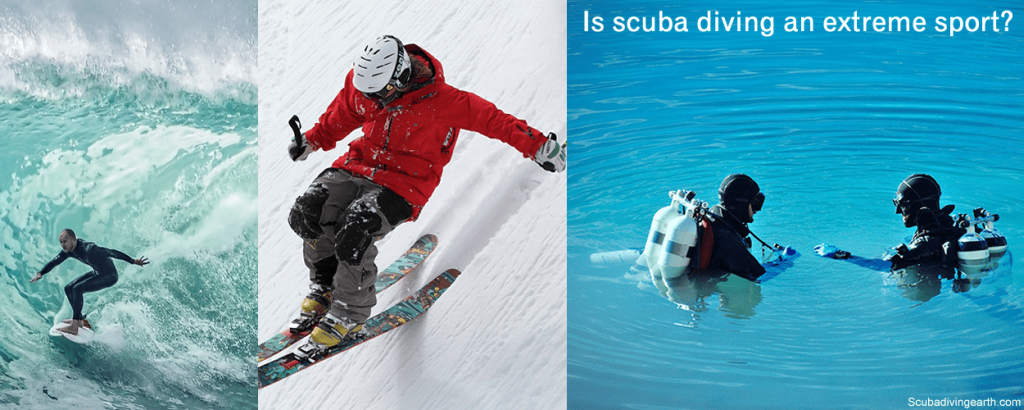
Is scuba diving an extreme sport?
Scuba diving is classed as an extreme sport. It’s extreme for a number of reasons:
- The environment you enter is totally foreign, as you can only scuba dive with the aid of breathing apparatus.
- Failure by your life support system (i.e. aqualung failure) means you can no longer breathe. That’s why the buddy diving system is important to follow.
- Insurance companies classify scuba diving as an extreme sport. Many travel insurance companies exclude scuba diving or limit the depth for insurance cover.
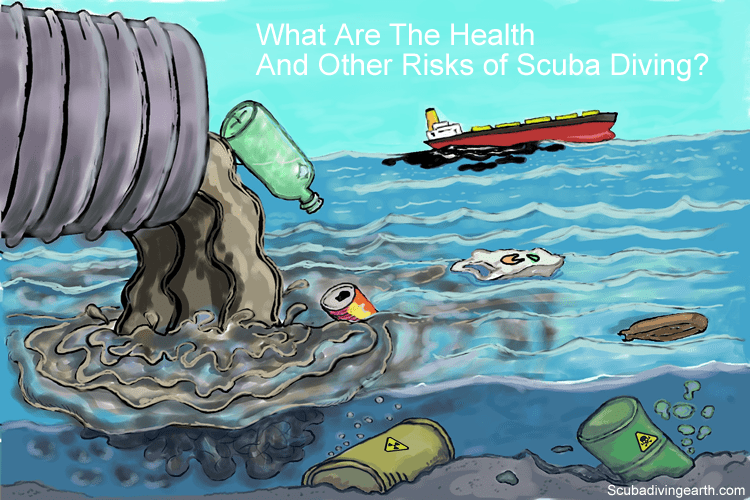
What are the risks of scuba diving?
There are a number of risks associated with scuba diving.
10 of the biggest dangers divers face:
- Decompression sickness.
- Arterial gas embolism.
- Drowning.
- Ear Barotrauma.
- Dangerous sea creatures.
- Running out of air.
- Nitrogen Narcosis.
- Oxygen Toxicity.
- Equipment failure.
- Types of scuba diving.
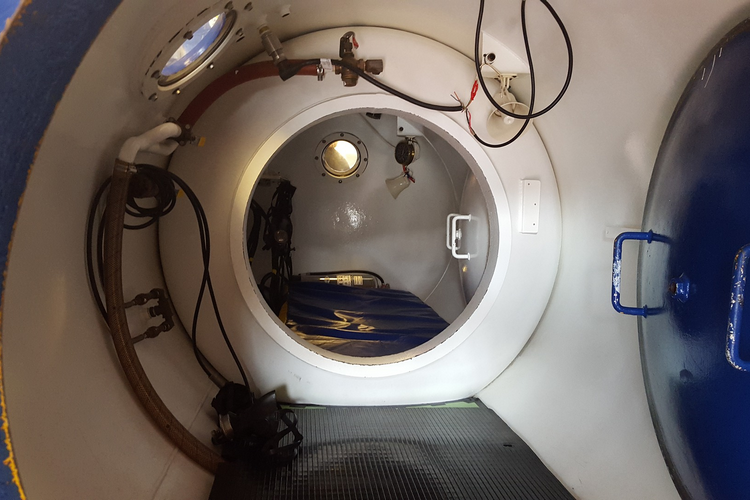
1. Decompression sickness can make it dangerous to scuba dive
Decompression sickness (DCS) is a risk associated with scuba diving. But decompression sickness is easily preventable if you carefully follow dive tables and computers. DCS is caused by nitrogen bubbles forming in your body if you ascend too quickly from depth.
When you breathe compressed air at depth your body tissues absorb more nitrogen than normal. The extra dissolved nitrogen is the reason why you must use a controlled slow ascent to allow time for this nitrogen to off-gas without forming bubbles.
Decompression sickness (DCS) or the bends is dangerous and can result in minor skin bends to at worst paralysis or even death.
How to avoid decompression sickness
Decompression sickness is one of the easiest dangers to avoid scuba diving. The safest way to avoid decompression sickness is to buy a dive computer. Use a dive computer to calculate your bottom time and ascent rates and you should be safe. Add in a safety stop on all dives as an extra precaution and the risk of decompression sickness will be minimised.
One of the safest ways to scuba dive and avoid the dangers of decompression sickness (DCS) is to always dive no decompression stop dives. This means your dive profile doesn’t require decompression stops on your ascent.
However, having said that you still need to follow the correct ascent speed. The speed at which you must ascend from your dive should be no faster than 30 feet per minute. Or put another way you should ascend slower that your smallest exhaust bubbles, which are the size of Champagne bubbles.
2. Arterial gas embolism from lung over expansion
An arterial gas embolism, as a result of pulmonary barotrauma (or a lung over expansion) scuba diving, causes damage to the lungs. A pulmonary barotrauma is dangerous to scuba divers and can be caused by holding your breath on your ascent. The damage from a pulmonary barotrauma is serious and can result in death. As you ascend from a dive the pressure around you reduces.
How you avoid an arterial gas embolism a pulmonary barotrauma
The dangers of an arterial gas embolism and pulmonary barotrauma are easy to avoid by following the golden rule of scuba diving, which is to never hold your breath.
Breathe normally when you scuba dive and you will avoid a lung over expansion or pulmonary barotrauma.
3. Drowning scuba diving
Drowning scuba diving is a danger that scuba divers face, but drowning typically occurs as a result of another event. For example, drowning can happen as a result of running out of air (see below), equipment failure (see below) or from a panic attack.
Also, you should only ever dive if you are fit to do so. As scuba diver drownings occur as a result of health problems like a cardiac or respiratory condition.
If you are prone to diver panic, try Panic Miracle to help you with panic attacks. Also, take a read of this article about how to overcome panic when scuba diving too.
How you avoid the risk of drowning scuba diving
The dangers of drowning whilst scuba diving can be avoided by never diving without a buddy. Checking your air on a regular basis and making sure your diving equipment is regularly maintained. You should also read this article about the 10 safety tips for scuba diving. Tip 7 explains how often to check your air a different depths.
4. Dangers of an ear Barotrauma scuba diving
An ear barotrauma is a risk associated with scuba diving, which can result from not equalising your ears during descent. Whilst an ear barotrauma is not life threatening it can stop you from diving in the future.
A middle ear barotrauma is caused by the damage from increased underwater pressure on the air pocket in the middle ear. The damage caused is a perforated eardrum, which will result in vertigo and pain.
How you avoid middle ear barotrauma
How you avoid an ear barotrauma is to equalise your ears immediately you leave the surface and regularly on your dive descent. Don’t wait for the ears to feel painful before equalising your ears. Also, avoid scuba diving with a cold or congestion.
The biggest pressure change occurs in the first 10 metres (33 feet) of the dive. This is when ear equalisation is most important and is when most ear barotraumas occur.
If you are struggling to equalise your ears on your descent, ascend slightly to relieve the pressure. This will often help to clear any blockage, making it easy to equalise your ears when you start to descend again.
Never force the equalisation as this may also damage or perforate the ear drum.
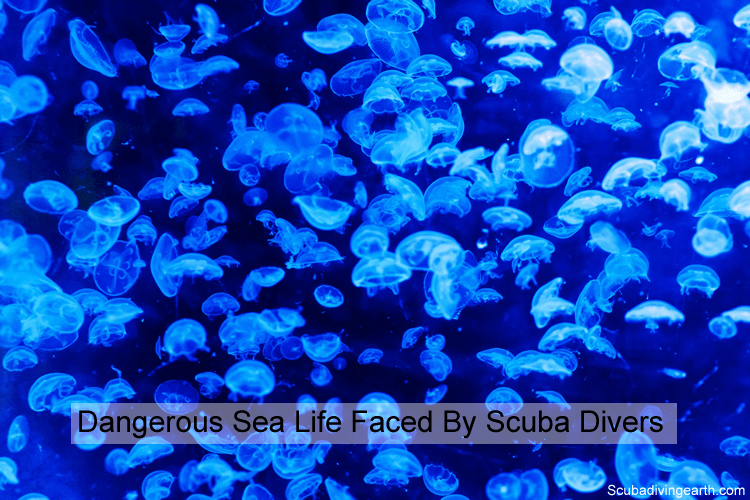
5. Dangerous sea creatures faced by scuba divers
One of the dangers of scuba diving is related to the sea life you encounter underwater. There are many dangerous creatures that can and do kill scuba divers. However, deaths associated with underwater sea creatures are very rare.
Diving with sharks can be dangerous, but it’s not as dangerous as some would make it out to be. There are other creatures that pose a much greater threat to scuba divers than sharks. These include jelly fish, sting rays, blue ringed octopus, scorpion fish, stone fish and cone snails.
Click this link for more details about diving with dangerous animals.
How you avoid the dangers of sea life scuba diving
The best way to avoid the dangers associated with sea creatures is to avoid confronting or provoking them. Most of the attacks on water users by sharks is due to provocation. Provocation includes spear fishing and the shark feeding.
This spear fisherman is attached by a bull shark, but the bull shark comes off worst. It’s a shame for the shark, but this is what can happen if you provoke sharks in this way. See below about how many scuba divers get attacked by sharks each year.
Most of us remember the death of Steve Irwin from the sting of a sting ray. This resulted from him getting too close to the sting ray.
It’s normally safe to scuba dive next to sting rays, but you must respect them and keep to a safe distance. Especially from their tails.
6. Running out of air scuba diving
The number one reason why scuba divers die is due to running out of air. This can happen to beginner divers who forget to check their air. But if you have a dive buddy if you mistakenly run out of air you can use their alternative air source.
How you avoid the danger of running out of air
The way you avoid the danger of running out of air is to check your air contents gauge regularly. The frequency with which you check your air does depend on your depth. The deeper you are the more frequently you should check it.
You should read this article about the 10 safety tips for scuba diving. In particular this section on checking your air contents gauge. This gives you a rough guide to how often you should check your air.
For example, at 15-20 metres you should check your air every 10-12 minutes. You may feel this is excessive, but by checking your air on a regular basis will get you into a good habit and it will mean you never run out.
Always leave the bottom with enough air to get you to the surface with at least 50 bar (725 psi) in your air tank. This includes having enough air for a safety stop at 5-6 metres (16-20 feet) for three minutes.
Always dive with with a dive buddy just in case you run out so you can use your dive buddy’s alternative air supply to get you to the surface.
More Reading: How do I get a dive buddy? (5 easy ways to find a dive buddy)
7. Nitrogen narcosis
Nitrogen narcosis or raptures of the deep usually affects divers at depths greater than 30 metres (98 feet). There are two common symptoms of nitrogen narcosis, which are:
- Some scuba divers become euphoric as a result of nitrogen narcosis. This euphoria can lead to divers removing their mouthpiece.
- Nitrogen narcosis can also cause extreme fear and dread. This could result in panic and lead to other associated problems underwater.
Nitrogen narcosis isn’t necessarily dangerous, but either of the above symptoms can lead to other more dangerous incidents.
More Reading: What causes nitrogen narcosis? (Is ‘raptures of the deep’ dangerous?)
How you avoid nitrogen narcosis and the associated dangers
Nitrogen narcosis mostly affects scuba divers on deeper dives in excess of 30 metres (100 feet). Which means you can avoid getting nitrogen narcosis by diving no deeper than 30 metres. Alternatively, diving using nitrox can help with nitrogen narcosis as nitrox reduces the amount of nitrogen in the gas you breathe.
Another mistake that divers make is to dive too deep too quickly. Instead you should build up your depth slowly and don’t make your first dive of the season to over 30 metres. Building your depth slowly builds-up your resistance to the the amount of nitrogen in your system, which reduces the chance of getting nitrogen narcosis..
More Reading: At what depth does nitrogen narcosis occur? (Raptures of the DEEP)
8. Oxygen toxicity at depth is dangerous to scuba divers
The percentage of oxygen in atmospheric air (i.e. 21%) can be toxic at depths of greater than 60 metres (200 feet).
Also, divers who use nitrox for scuba diving need to be aware of the depth limitations for the percentage of nitrox mix they use. You might like to read this article about how deep you can dive with nitrox.
How you avoid the dangers of oxygen toxicity
The easiest way in which to avoid oxygen toxicity is not to dive deeper than 50 metres (164 feet) on atmospheric air. But if you choose to dive deeper than 50 metres you will need to dive on mixed gasses instead.
Diving on mixed gasses is technical diving for advanced divers.
9. Equipment failure scuba diving
One of the dangers divers face is equipment failure, with the worst failure of is if your aqualung (air tank and regulators) fails.
Scuba divers rely on a life support system, which consists of your regulators and your air tank. If this goes wrong underwater you could be in trouble.
In case you think this can’t happen, I’ve had two occasions when I’ve had to come to the rescue of a dive buddy. Both times this was a failure with their air supply. The first had their first stage hose fail. The second had a malfunctioning first stage. I managed to bring both divers to the surface safely.
How you avoid the dangers associated with scuba diving equipment failure
The best way to avoid diving equipment failure is to have it serviced regularly.
However, even if scuba equipment is serviced regularly it can still fail. Which is why you should never dive without a buddy. Your buddy is your backup in case your equipment fails, as are you their backup if their equipment fails.
10. Types of scuba diving can be dangerous
Certain types of scuba diving are more dangerous than others. For example, cave diving is classed as one of the most dangerous sports in the world. Insurers will not insure cave divers as it is so dangerous.
Cave diving is one of the most challenging and potentially dangerous kinds of diving. This is because:
- Caves often contain sand, mud, clay, silt, or other sediment that can reduce underwater visibility when its stirred up. This can lead to disorientation and result in panic.
- It’s very easy for scuba divers to get lost in caves.
- If you have equipment failure in a cave it’s much more difficult to return to the surface as you’re diving in an overhead environment.
Similar to cave diving is wreck penetration diving. It’s similar because you are in an overhead environment. There are many dangers associated with penetrating a wreck, which include:
- Getting lost and stuck inside the wreck.
- Part of the wreck may dislodge whilst you are in it.
- Similar to cave diving there is often a build-up of silt. It’s extremely easy yo stir up this silt with your fins and become completely disorientated and lost.
Deep diving is another type of diving that’s more dangerous than recreational diving to shallower depths. The deeper you dive the more risks there are of things going wrong. Diving deeper usually requires decompression stops which carries more risk.
How you avoid risks associated with more dangerous types of diving
The easiest way in which to avoid the dangers associated with more risky diving types, like cave diving, is to simply not do it.
But if you are keen to do more adventurous type of diving, like cave diving, wreck penetration and deeper dives make sure you get suitably trained and to plan your dives carefully.
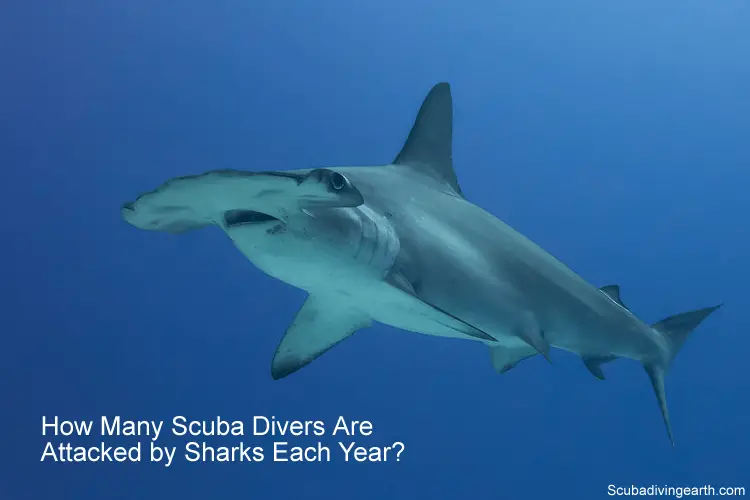
How many scuba divers get attacked by sharks each year?
To put things into perspective about scuba diving with sharks, there were only 6 fatalities from shark attacks in 2010. But non of these attacks were on scuba divers.
Humans are not on the natural menu for sharks, so sharks do not hunt humans. When they occasionally bite they most often move on.
The average number of deaths from shark attacks between 2001 and 2010 was 4.3 per year. But the chance of a shark attack while scuba diving is almost zero.
More Reading: What should you not do after scuba diving (11 must NOT do’s after diving)
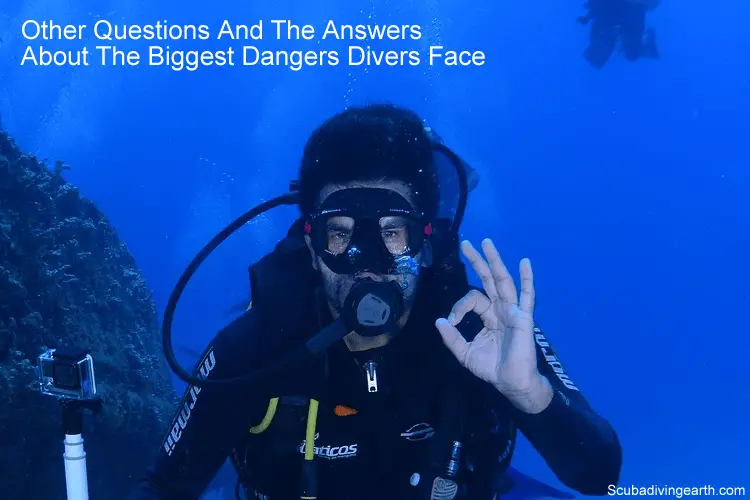
Questions and answers about is it dangerous to scuba dive
There are many other questions that beginner scuba divers ask about the biggest dangers divers face, these include the following:
Is scuba diving dangerous at 30 feet?
The question: Is scuba diving dangerous at 30 feet.
The answer: Yes potentially, please read on…
Diving to 30 feet (9 metres) isn’t as dangerous as diving deeper. But you still need to be careful when you are diving a shallow dive. Scuba diving is about respecting the environment you are in.
For example, you are can just as easily run out of air at 30 feet, as you can at 100 feet. Your air will last longer at 30 feet, but if you’re not paying attention to your air consumption you could quite easily run out.
One of the greatest scuba diving dangers at 30 feet is an arterial gas embolism. This is because the biggest change in pressure occurs in the first 10 metres (32 feet) of water.
The water pressure at 30 feet is twice that of what it is on the surface. If you took a deep breath in at just 30 feet then came to the surface without breathing out your lungs would burst. The air in your lungs would literally double in size between 30 feet and the surface.
Other dangers at 30 feet include dangerous animals. You are just as likely to land on a scorpion fish or a stone fish at a shallow depth, as you are when you dive deeper.
Pro diver tip: The best attitude to adopt no matter what the depth of dive, be it 30 feet or 30 metres is to always think safe diving. That way you will always avoid the dangers of scuba diving.
Is scuba diving scary?
The question: Is scuba diving scary.
The answer: It can be for some…
Scuba diving can be scary for some, which is often about their own anxieties of phobias they have. There are many phobias that can prevent some from even learning to scuba dive.
For example:
- Many suffer from scuba diving claustrophobia. This can affect people in the most basic way. Many fear even putting a scuba diving mask on their face.
- Others don’t like the idea of having to breathe through their mouth.
- Some people have aquaphobia, which is a specific fear of water. If you have aquaphobia scuba diving is a non-starter and would be extremely scary.
- Then there’s thalassophobia, which is an intense and persistent fear of the sea or of sea travel. Thalassophobia can include fear of being in large bodies of water or the fear of deep dark water. Thalassophobia would also make scuba diving feel extremely scary, and probably a non-starter also.
- Scuba diving can also be scary for those that are scared of sharks. A fear of sharks is known as Galeophobia or Selachophobia.
If you associate with any of these fears or phobias, but if you’d love to experience weightlessness and visit the underwater world lease try out this ‘PanicMiracle.’
Click this link to find out more about the Panic Miracle.
The PanicMiracle is the only clinically proven drug free holistic system for treating panic attacks and general anxiety.
PanicMiracle
Please don’t forget to take a look at this article about where to find great white sharks, you may be as surprised as I was to discover some of the places where you find great white sharks! Place number 6 is the one that surprised me the most, but if you live in the States, you may be more surprised at places two, three and four.
I hope you enjoyed this article about is it dangerous to scuba dive
I’d love to hear from you. Tell us about your adventures of diving and snorkeling, in the comments below. Please also share your photos. Either from your underwater cameras or videos from your waterproof gopro’s!
If this article hasn’t answered all of your questions. If you have more questions either about snorkeling or scuba diving (or specifically about is it dangerous to scuba dive), please comment below with your questions.
There will also be many more articles about scuba diving (and on snorkeling) for you to read and learn about this fabulous sport.
Have fun and be safe!

